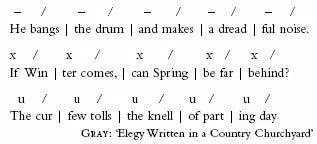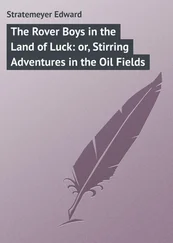
For the most part I shall be sticking to  and
and  however, as I find they represent the ti and the tummore naturally. Besides, the other scansion marks derive from classical metre, which was concerned with vowel length rather than stress.
however, as I find they represent the ti and the tummore naturally. Besides, the other scansion marks derive from classical metre, which was concerned with vowel length rather than stress.
The Great Iamb (and other binary feet)
The word for a rising-rhythm foot with a ti- tum,  beat like those above is an iambus, more usually called an IAMB.
beat like those above is an iambus, more usually called an IAMB.
I remember this by thinking of Popeye, whose trademark rusty croak went:I yam what I yam …  Iámb, iámb, iámb
Iámb, iámb, iámb
We will concentrate on this foot for the rest of this section, but you should know that there are three other feet in the same BINARY (two unit) family.
The TROCHEE is a backwards iamb, a falling rhythm, tum-ti:

The trochee obeys its own definition and is pronounced to rhyme with poky or choky.
 Thuswas bornmy Hia watha, Thuswas bornthe childof wonder;LONGFELLOW: The Song of Hiawatha
Thuswas bornmy Hia watha, Thuswas bornthe childof wonder;LONGFELLOW: The Song of Hiawatha
As a falling rhythm, a tick-tock, tick-tock, tick-tock, it finishes on an unaccented syllable–an ‘and’ if you’re counting and clapping musically:

The SPONDEE is of equal stressed units:  This also obeys its own definition and is pronounced to rhyme with the name John Dee . You may feel that it is almost impossible to give absolutely equal stress to two successive words or syllables in English and that there will always be some slight difference in weight. Many metrists (Edgar Allan Poe among them) would argue that the spondee doesn’t functionally exist in English verse. Again, we’ll think about the ramifications later, for the time being you might as well know it.
This also obeys its own definition and is pronounced to rhyme with the name John Dee . You may feel that it is almost impossible to give absolutely equal stress to two successive words or syllables in English and that there will always be some slight difference in weight. Many metrists (Edgar Allan Poe among them) would argue that the spondee doesn’t functionally exist in English verse. Again, we’ll think about the ramifications later, for the time being you might as well know it.

The fourth and final permutation is of unstressed units  and is called the PYRRHIC foot. Don’t bother to think about the pyrrhic either for the moment, we’ll be looking at it later. All the feet possible in English are gathered in a table at the end of the chapter, with examples to demonstrate their stresses.
and is called the PYRRHIC foot. Don’t bother to think about the pyrrhic either for the moment, we’ll be looking at it later. All the feet possible in English are gathered in a table at the end of the chapter, with examples to demonstrate their stresses.
The iamb is the hero of this chapter, so let us take a closer look at it:

Ten syllables, yes, but a count, or measure, of five feet, five iambic feet, culminating (the opposite of the trochaic line) in a strong or accented ending. SAY IT OUT LOUD AGAIN:and oneand twoand threeand fourand fiveHe bangsthe drumand makesa dreadful noise
It is a measure of five and the prosodic word, from the Greek again, for ‘measure of five’ is PENTAMETER. That simple line is an example therefore of IAMBIC PENTAMETER.
The Iambic Pentameter
The rising rhythm of the five-beat iambic pentameter has been since the fourteenth century the most widely used metre in English poetry. Chaucer’s Canterbury Tales , Spenser’s Faerie Queen , Shakespeare’s plays and sonnets, Milton’s Paradise Lost , the preponderance of verse by Dryden, Pope, Wordsworth, Keats, Browning, Tennyson, Owen, Yeats and Frost, all written in iambic pentameter. It is the very breath of English verse and has earned the title the HEROIC LINE.
Poetry Exercise 1
Try reading the following extracts out loud to yourself, noting the varying pulses, some strong and regularly accented, others gentler and more flowing. Each pair of lines is an example of ‘perfect’ iambic pentameter, having exactly ten syllables, five iambic feet (five stresses on the even-numbered beats) to the line. Once you’ve read each pair a few times, TAKE A PENCIL AND MARK UP EACH FOOT. Use a  or a / for the accented syllables or words and a
or a / for the accented syllables or words and a  or a–for the un accented syllables or word. I have double-spaced each pair to make it easier for you to mark them.
or a–for the un accented syllables or word. I have double-spaced each pair to make it easier for you to mark them.
I really would urge you to take time over these: savour every line. Remember GOLDEN RULE ONE–reading verse can be like eating chocolate, so much more pleasurable when you allow it slowly to melt inside you, so much less rewarding when you snap off big chunks and bolt them whole, all but untasted.
DON’T LET YOUR EYE FALL FURTHER DOWN THE PAGE THAN THIS LINE until you have taken out your pencil or pen. You may prefer a pencil so that you can rub out your marks and leave this book in pristine condition when you lend it to someone else–naturally the publishers would prefer you to buy another copy for your friends–the important thing is to get used to defacing this book in one way or another. Here are the rules of the exercise again:
Read each pair of lines out loud, noting the ti- tumrhythms.
Now MARK the weak/strong (accented/unaccented) syllables and the ‘bar lines’ that separate each foot in this manner:

Or you may find it easier with a pencil to do it like this:

When you have done this, read each pair of lines OUT LOUD once more, exaggerating the stresses on each beat.He sit hym up withouten wordes mo,And with his ax he smoot the corde atwo, 4
CHAUCER: The Canterbury Tales , The Reeve’s TaleThat time of year, thou mayst in me beholdWhen yellow leaves, or none, or few, do hang
SHAKESPEARE: Sonnet 73In sooth I know not why I am so sad:It wearies me; you say it wearies you;
SHAKESPEARE: The Merchant of Venice , Act I, Scene 1Their wand’ring course, now high, now low, then hidProgressive, retrograde, or standing still
MILTON: Paradise Lost , Book VIIIOft has our poet wisht, this happy SeatMight prove his fading Muse’s last retreat.
Читать дальше


 and
and  however, as I find they represent the ti and the tummore naturally. Besides, the other scansion marks derive from classical metre, which was concerned with vowel length rather than stress.
however, as I find they represent the ti and the tummore naturally. Besides, the other scansion marks derive from classical metre, which was concerned with vowel length rather than stress. beat like those above is an iambus, more usually called an IAMB.
beat like those above is an iambus, more usually called an IAMB. Iámb, iámb, iámb
Iámb, iámb, iámb
 Thuswas bornmy Hia watha, Thuswas bornthe childof wonder;LONGFELLOW: The Song of Hiawatha
Thuswas bornmy Hia watha, Thuswas bornthe childof wonder;LONGFELLOW: The Song of Hiawatha
 This also obeys its own definition and is pronounced to rhyme with the name John Dee . You may feel that it is almost impossible to give absolutely equal stress to two successive words or syllables in English and that there will always be some slight difference in weight. Many metrists (Edgar Allan Poe among them) would argue that the spondee doesn’t functionally exist in English verse. Again, we’ll think about the ramifications later, for the time being you might as well know it.
This also obeys its own definition and is pronounced to rhyme with the name John Dee . You may feel that it is almost impossible to give absolutely equal stress to two successive words or syllables in English and that there will always be some slight difference in weight. Many metrists (Edgar Allan Poe among them) would argue that the spondee doesn’t functionally exist in English verse. Again, we’ll think about the ramifications later, for the time being you might as well know it.
 and is called the PYRRHIC foot. Don’t bother to think about the pyrrhic either for the moment, we’ll be looking at it later. All the feet possible in English are gathered in a table at the end of the chapter, with examples to demonstrate their stresses.
and is called the PYRRHIC foot. Don’t bother to think about the pyrrhic either for the moment, we’ll be looking at it later. All the feet possible in English are gathered in a table at the end of the chapter, with examples to demonstrate their stresses.











